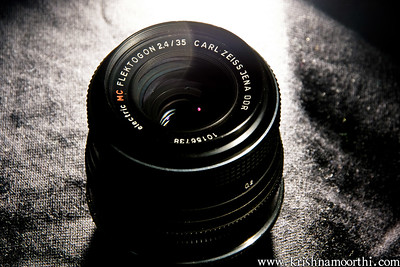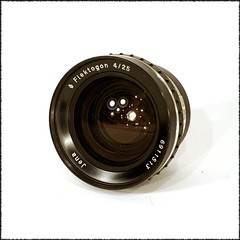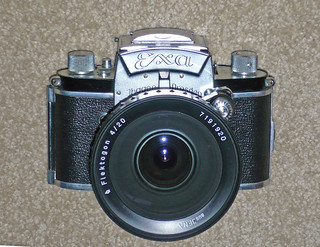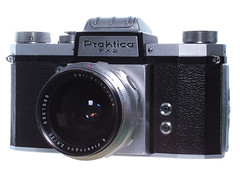Difference between revisions of "Flektogon"
m (reworded) |
|||
| (10 intermediate revisions by 4 users not shown) | |||
| Line 1: | Line 1: | ||
| − | |||
| − | |||
| − | |||
| − | |||
| − | |||
{{Flickr_image | {{Flickr_image | ||
| − | |image_source= | + | |image_source= http://www.flickr.com/photos/mjuboy/2551865950/in/pool-camerawiki |
| − | |image= | + | |image= http://farm4.static.flickr.com/3162/2551865950_3e0408468f_w.jpg |
| − | |image_align= | + | |image_align= right |
| − | |image_text= | + | |image_text= 2.4/35, for ''electric'' variant of the [[M42]] screw mount as<br/>used on the [[Praktica PLC 2/PLC 3]] |
| − | |image_by= | + | |image_by= Kishor Krishnamoorthi |
|image_rights= wp | |image_rights= wp | ||
}} | }} | ||
| + | The '''Flektogon''' was an early [[Lens#Wide-angle|wide angle lens]] of its type with a short [[Lens#focal length|focal length]] yet a long back focus distance - the product launch of the cine [[retrofocus]] design of [[Angénieux]] preceded the Flektogon's introduction, but both were developed almost at the same time. It was developed in 1949 by Rudolf Solisch, aided by a few professional optical calculators at [[Carl Zeiss|VEB Carl Zeiss Jena]], the East German Zeiss optics company, and introduced in 1950. The first variant was the Flektogon 2.8/35 for 35mm [[SLR]]s, which is a kind of a 6-element ''[[Biometar]]'' lens with additional big meniscus lens added as seventh element, positioned as the lens's front element near the "biometary" elements' focus point, thus not enhancing their combined focal length, but the back focus distance of the lens's whole optical system. Soon the number of elements could be reduced to six. | ||
| + | |||
| + | Later other [[35mm]] variants were made: 4/25, the remarkable fast 2.4/35, the first super-wide angle lens 4/20 (1961) and the outstanding Flektogon 2,8/20 (1976). From 1978 lenses were also made for the bayonet connection of Praktica B-series with the name "Prakticar". | ||
| + | [[Medium format]] variants were made for the [[Pentacon Six]]: 2.8/65 and 4/50. | ||
| + | Other lens makers like Carl Zeiss Oberkochen (West Germany) made similar lenses like the '''Distagon'''. It's a rare case of an eastern product copied in the West. Production of the manual-focusing Flektogon ended in 1991 whilst the Distagons are still in the market. A new variant by [[Carl Zeiss]] is the [[autofocus]] Flektogon 1:3,5/35mm for the Rolleiflex 6008 AF. | ||
| + | {{br}} | ||
{{Flickr_image | {{Flickr_image | ||
| − | |image_source= http://www.flickr.com/photos/ | + | |image_source= http://www.flickr.com/photos/draculro/15581760659/in/pool-camerawiki/ |
| − | |image= http:// | + | |image= http://farm6.staticflickr.com/5616/15581760659_0202133d3b_n.jpg |
|image_align= left | |image_align= left | ||
| − | |image_text= | + | |image_text= Carl Zeiss Jena Flektogon 20mm f/4 |
| − | |image_by= | + | |image_by= Nicodemus Roger |
| − | |image_rights= | + | |image_rights= with permission |
}} | }} | ||
| − | |||
{{Flickr_image | {{Flickr_image | ||
|image_source= http://www.flickr.com/photos/stammi/4196735693/in/pool-camerawiki | |image_source= http://www.flickr.com/photos/stammi/4196735693/in/pool-camerawiki | ||
| Line 30: | Line 30: | ||
|image_by= stammi | |image_by= stammi | ||
|image_rights= cc | |image_rights= cc | ||
| + | }} | ||
| + | {{Flickr_image | ||
| + | |image_source= https://www.flickr.com/photos/gearporn/6842675225/in/pool-camerawiki | ||
| + | |image= https://live.staticflickr.com/7004/6842675225_ace6da829c_m_d.jpg | ||
| + | |image_align= left | ||
| + | |image_text= MC Flektogon 2.8/20 | ||
| + | |image_by= Yumi Abe | ||
| + | |image_rights= nc | ||
| + | }} | ||
| + | {{br}} | ||
| + | {{Flickr_image | ||
| + | |image_source= http://www.flickr.com/photos/martin-tai/32470886774/in/pool-camerawiki/ | ||
| + | |image= http://farm4.staticflickr.com/3727/32470886774_93be995956_n.jpg | ||
| + | |image_align= left | ||
| + | |image_text= Flektogon 4/20 on an Ihagee Exa | ||
| + | |image_by= martintai838 | ||
| + | |image_rights= wp | ||
}} | }} | ||
{{Flickr_image | {{Flickr_image | ||
| Line 41: | Line 58: | ||
{{Flickr image | {{Flickr image | ||
| image_source=http://www.flickr.com/photos/mflenses/4046187448/in/pool-camerawiki | | image_source=http://www.flickr.com/photos/mflenses/4046187448/in/pool-camerawiki | ||
| − | | image=http://farm3.static.flickr.com/2602/ | + | | image=http://farm3.static.flickr.com/2602/4046187448_13cdf6e510_n.jpg |
| image_align= left | | image_align= left | ||
| image_text=Pentacon Six with Flektogon | | image_text=Pentacon Six with Flektogon | ||
| Line 47: | Line 64: | ||
|image_rights=wp | |image_rights=wp | ||
}} | }} | ||
| − | {{ | + | {{brl}} |
| − | |||
| − | |||
| − | |||
| − | |||
| − | |||
| − | |||
| − | |||
| − | |||
==Links== | ==Links== | ||
| Line 61: | Line 70: | ||
*[http://www.flickr.com/photos/camerawiki/6820638873/in/pool-camerawiki Diagram of the Flektogon 20/4] scan courtesy [http://www.flickr.com/photos/vox/ Voxphoto] on Flickr | *[http://www.flickr.com/photos/camerawiki/6820638873/in/pool-camerawiki Diagram of the Flektogon 20/4] scan courtesy [http://www.flickr.com/photos/vox/ Voxphoto] on Flickr | ||
*[http://www.flickr.com/groups/flektogon Flickr group Flektogon] | *[http://www.flickr.com/groups/flektogon Flickr group Flektogon] | ||
| + | *[https://zeissikonveb.de/start/objektive/wechselobjektive1950er/carl-zeiss-jena/flektogon-2-8-35.html Flektogon history] in German, on zeissikonveb.de [https://zeissikonveb.de/] | ||
[[Category:German lenses]] | [[Category:German lenses]] | ||
[[Category:Carl Zeiss]] | [[Category:Carl Zeiss]] | ||
Latest revision as of 10:56, 17 March 2024

|
| 2.4/35, for electric variant of the M42 screw mount as used on the Praktica PLC 2/PLC 3 image by Kishor Krishnamoorthi (Image rights) |
The Flektogon was an early wide angle lens of its type with a short focal length yet a long back focus distance - the product launch of the cine retrofocus design of Angénieux preceded the Flektogon's introduction, but both were developed almost at the same time. It was developed in 1949 by Rudolf Solisch, aided by a few professional optical calculators at VEB Carl Zeiss Jena, the East German Zeiss optics company, and introduced in 1950. The first variant was the Flektogon 2.8/35 for 35mm SLRs, which is a kind of a 6-element Biometar lens with additional big meniscus lens added as seventh element, positioned as the lens's front element near the "biometary" elements' focus point, thus not enhancing their combined focal length, but the back focus distance of the lens's whole optical system. Soon the number of elements could be reduced to six.
Later other 35mm variants were made: 4/25, the remarkable fast 2.4/35, the first super-wide angle lens 4/20 (1961) and the outstanding Flektogon 2,8/20 (1976). From 1978 lenses were also made for the bayonet connection of Praktica B-series with the name "Prakticar". Medium format variants were made for the Pentacon Six: 2.8/65 and 4/50.
Other lens makers like Carl Zeiss Oberkochen (West Germany) made similar lenses like the Distagon. It's a rare case of an eastern product copied in the West. Production of the manual-focusing Flektogon ended in 1991 whilst the Distagons are still in the market. A new variant by Carl Zeiss is the autofocus Flektogon 1:3,5/35mm for the Rolleiflex 6008 AF.

|
| Carl Zeiss Jena Flektogon 20mm f/4 image by Nicodemus Roger (Image rights) |

|
| Flektogon 4/25 image by stammi (Image rights) |

|
| MC Flektogon 2.8/20 image by Yumi Abe (Image rights) |

|
| Flektogon 4/20 on an Ihagee Exa image by martintai838 (Image rights) |

|
| Flektogon 2.8/35 image by Michele M. F. (Image rights) |

|
| Pentacon Six with Flektogon image by mflenses (Image rights) |
Links
- Flektogon in German Wikipedia
- Diagram of the Flektogon 20/4 scan courtesy Voxphoto on Flickr
- Flickr group Flektogon
- Flektogon history in German, on zeissikonveb.de [1]